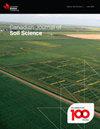Integrated agroforestry system affects the dynamics of inorganic phosphorus fractions in the savanna of Brazilian Northeast
IF 1.5
4区 农林科学
Q4 SOIL SCIENCE
引用次数: 0
Abstract
The savanna (Cerrado) of northeastern Brazil has undergone significant transition in land use to expand agricultural activities. In this region, soils are highly weathered, with phosphorus (P) commonly bound to aluminum (Al) and iron (Fe), creating conditions that demand the supply of P fertilizers to build soil fertility. Conservation systems, such as integrated agroforestry, can increase the inorganic P lability. The aim of this study was to evaluate soil P availability in components of an integrated agroforestry system. Four systems were studied from a 3-year experiment: eucalyptus ( E. urophylla × E. tereticornis) rows (ER), sabiá ( Mimosa caesalpiniifolia) rows (SR), inter-planted maize, and inter-planted soybean in addition to an area of native Cerrado (NC) used as a control. Inter-planted soybean and maize components showed an increase in available P in relation to NC, as a response to a liming-induced increase in soil pH and phosphate fertilization. Eucalyptus and sabiá row components showed an increase in available P in soil because of higher P recycling promoted by forest species and lower P adsorption onto Fe and Al due to the high concentrations of organic matter. Phosphorus forms, following a descending order for all components of the agroforestry system, are P–Al > P–Fe > P–Ca. This information can be used to improve management and soil quality of agricultural production in the Cerrado of the Brazilian northeast region.综合农林系统影响巴西东北部热带稀树草原无机磷组分的动态变化
为扩大农业活动,巴西东北部的热带稀树草原(Cerrado)经历了土地使用的重大转变。该地区的土壤风化严重,磷通常与铝(Al)和铁(Fe)结合在一起,这就需要提供磷肥来提高土壤肥力。综合农林业等水土保持系统可以提高无机磷的稳定性。本研究的目的是评估综合农林业系统各组成部分的土壤钾可用性。在为期 3 年的实验中研究了四种系统:桉树(E. urophylla × E. tereticornis)行(ER)、sabiá(Mimosa caesalpiniifolia)行(SR)、间作玉米和间作大豆,以及作为对照的原生塞拉多地区(NC)。与 NC 相比,间作大豆和玉米的可用钾含量有所增加,这是对土壤 pH 值和磷肥施用引起的土壤酸化的反应。桉树和沙比利行种植区土壤中的可利用钾有所增加,这是因为森林物种促进了更高的钾循环利用,而高浓度的有机物降低了铁和铝对钾的吸附。在农林系统的所有组成部分中,磷的形态依次为 P-Al > P-Fe > P-Ca。这些信息可用于改善巴西东北部塞拉多地区农业生产的管理和土壤质量。
本文章由计算机程序翻译,如有差异,请以英文原文为准。
求助全文
约1分钟内获得全文
求助全文
来源期刊

Canadian Journal of Soil Science
农林科学-土壤科学
CiteScore
2.90
自引率
11.80%
发文量
73
审稿时长
6.0 months
期刊介绍:
The Canadian Journal of Soil Science is an international peer-reviewed journal published in cooperation with the Canadian Society of Soil Science. The journal publishes original research on the use, management, structure and development of soils and draws from the disciplines of soil science, agrometeorology, ecology, agricultural engineering, environmental science, hydrology, forestry, geology, geography and climatology. Research is published in a number of topic sections including: agrometeorology; ecology, biological processes and plant interactions; composition and chemical processes; physical processes and interfaces; genesis, landscape processes and relationships; contamination and environmental stewardship; and management for agricultural, forestry and urban uses.
 求助内容:
求助内容: 应助结果提醒方式:
应助结果提醒方式:


